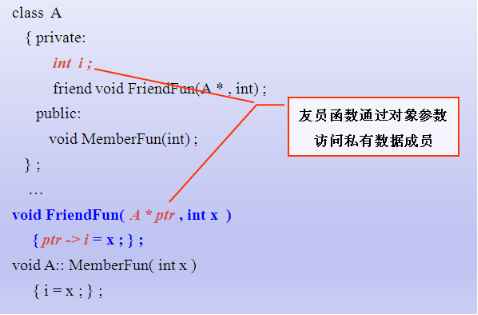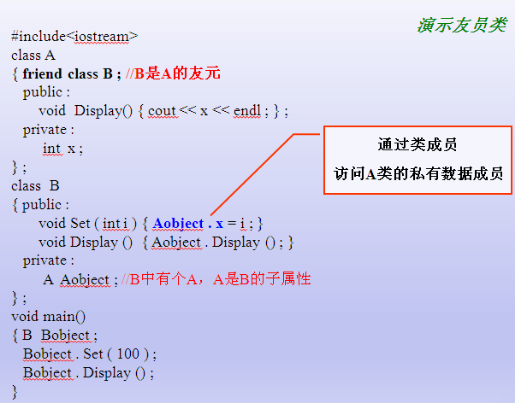目录:
1. C的提高 1-131P 时间七天
2. C++的基础 132-286P 时间八天
3. C++的提高 287-378P 时间五天
4. C/C++的数据结构 379-482P 时间五天
5. C/C++的设计模式基础 483-540P 时间三天
视频资料:https://www.bilibili.com/video/av27904891?from=search&seid=10891514449061956870
P200 const修饰的谁
#include <iostream> using namespace std; class Test { public: Test(int a, int b) //---> Test(Test *this, int a, int b) { this->a = a;//this就是t1取地址,谁调用它它就是谁 this->b = b; } void printT() { cout<<"a: " <<a <<endl; cout<< "b: " << this->b <<endl; } //1. const写在什么位置 没有关系 //2. const修饰的是谁 // 1. const修饰的是形参a 不是 // 2. const修饰的是属性this->a this->b // 3. const修饰的是this指针所指向的内存空间,指针所指向的内存空间不能被修改 void OpVar(int a,int b) const // void OpVar(const Test *const this, int a, int b) { a=100; //this->a=100; this->b=100; cout<< "b: " << this->b <<endl; } protected: private: int a; int b; }; void main() { Test t1(1, 2); t1.printT();// ===> printT(&t1) cout<<"hello..."<<endl; system("pause"); return ; }
P202 全局函数PK成员函数
1、把全局函数转化成成员函数,通过this指针隐藏左操作数
Test add(Test &t1, Test &t2)===》Test add( Test &t2)
2、把成员函数转换成全局函数,多了一个参数
void printAB()===》void printAB(Test *pthis)
3、函数返回元素和返回引用
Test& add(Test &t2) //*this //函数返回引用 { this->a = this->a + t2.getA(); this->b = this->b + t2.getB(); return *this; //*操作让this指针回到元素状态 } Test add2(Test &t2) //*this //函数返回元素 { //t3是局部变量 Test t3(this->a+t2.getA(), this->b + t2.getB()) ; return t3; } void add3(Test &t2) //*this //函数返回元素 { //t3是局部变量 Test t3(this->a+t2.getA(), this->b + t2.getB()) ; //return t3; }
#include<iostream> using namespace std; class Test { public: int a; int b; public: ~Test() { cout<<"a:"<<a<<"b:"<<b; cout<<"析构函数自动调用"<<endl; } public: Test(int a=0,int b=0) { this->a=a; this->b=b; } public: //t3=t1.TestAdd(t2); Test TestAdd(Test &t2) { Test tmp(this->a+t2.a,this->b+t2.b); return tmp; } //t1.TestAdd2(t2); //返回一个引用,相当于返回一个变量自身 //返回t1这个元素 this就是t1的地址 Test& TestAdd2(Test &t2) { this->a=this->a+t2.a; this->b=this->b+t2.b; return *this;//把(&t1)又回到了t1元素 } public: void printT() { cout<<"a:"<<a<<"b:"<<b<<endl; } protected: private: }; //全局函数的方法 //全局函数 转成 成员函数 少了一个参数 Test TestAdd(Test &t1,Test &t2) { Test tmp; return tmp; } //把成员函数转成全局函数 多了一个参数 void printT(Test *pT) { cout<<"a:"<<pT->a<<"b:"<<pT->b<<endl; } void main() { Test t1(1,2); Test t2(3,4); //t1=t1+t2 t1.TestAdd2(t2); t1.printT(); system("pause"); } void main181() { Test t1(1,2); Test t2(3,4); Test t3; //全局函数方法 //t1+t2 t3=TestAdd(t1,t2); t3.printT(); //成员函数方法 { //先把测试案例写出来 Test t4=t1.TestAdd(t2);//匿名对象直接转化成t4 t4.printT(); Test t5; t5=t1.TestAdd(t2);//匿名对象复制给t5 t5.printT(); } t3=t1.TestAdd(t2); system("pause"); }
P203 强化训练数组类--类的设计和测试程序
P204 类的实现和测试
MyArray.h
#pragma once //保证头文件只被编译一次
#include<iostream>
using namespace std;
class Array
{
public:
Array(int length);
Array(const Array& obj);
~Array();
public:
void setData(int index,int value);
int getData(int index);
int length();
private:
int m_length;
int *m_space;
};
MyArray.cpp
#include "MyArray.h"
//Array a1(10);
Array::Array(int length)
{
if (length<0)
{
length=0;
}
else
{
m_length=length;
m_space=new int[m_length];
}
}
//Array a2=a1;
Array::Array(const Array& obj)
{
this->m_length=obj.m_length;
//深拷贝 分配内存空间
this->m_space=new int[this->m_length];
for(int i=0;i<obj.m_length;i++)//数组元素赋值
{
this->m_space[i]=obj.m_space[i];
}
}
Array::~Array()
{
if (m_space!=NULL)
{
delete[] m_space;
m_length=0;
}
}
//a1.setData(i,i);
void Array::setData(int index,int value)
{
m_space[index]=value;
}
int Array::getData(int index)
{
return m_space[index];
}
int Array::length()
{
return m_length;
}
TestArray.cpp
#include<iostream>
#include "MyArray.h"
using namespace std;
//类的框架设计完毕
//类的测试案例
void main()
{
Array a1(10);
//赋值
for(int i=0;i<a1.length();i++)
{
a1.setData(i,i);
}
//获取
cout<<"打印a1"<<endl;
for(int i=0;i<a1.length();i++)
{
cout<<a1.getData(i) <<endl;
}
Array a2=a1;
cout<<"输入a2"<<endl;
//获取
cout<<"打印a2"<<endl;
for(int i=0;i<a2.length();i++)
{
cout<<a2.getData(i)<<endl;
}
system("pause");
}
P205 友元函数

友元函数是类的好朋友,在友元函数里可以修改这个类的私有属性,言外之意友元函数破坏了类的封装性
在这个类里声明了友元函数,这个友元函数是个全局函数,要想在友元函数去修改某一个变量的某个对象的私有属性,一般友元函数至少包含原类的参数,一个赋的值
说明语句的位置与访问描述无关

#include<iostream> using namespace std; class A { public: //声明的位置和public private没有关系 friend void modify(A *pA,int _a); //函数 modify是类A的好朋友 A(int a=0,int b=0) { this->a=a; this->b=b; } int getA() { return this->a; } private: int a; int b; }; void modify(A *pA,int _a) { //pA->a=100; pA->a=_a; } void main() { A a1(1, 2); cout<<a1.getA()<<endl; modify(&a1,300); cout<<a1.getA()<<endl; system("pause"); }
this是指A类 this->指类中的属性
类 *变量名 代表类的指针名为变量名,这个变量名就是这个类的指针
输出结果: 1 300
P206 友元类
- 若B类是A类的友员类,则B类的所有成员函数都是A类的友员函数
- 友员类通常设计为一种对数据操作或类之间传递消息的辅助类

#include<iostream> using namespace std; class A { public: friend class B;//声明B类是A的好朋友,在B中可以访问A的私有成员 私有函数 //声明的位置和public private没有关系 friend void modify(A *pA,int _a); //函数 modify是类A的好朋友 A(int a=0,int b=0) { this->a=a; this->b=b; } int getA() { return this->a; } private: int a; int b; }; void modify(A *pA,int _a) { //pA->a=100; pA->a=_a; } //为什么设计友元类函数 // 1.java--->1.class(字节码) ==》反射机制分析1.class 找到类对象。直接修改类的私有属性 // 反射机制 成为一种标准。。。。jdk ...sun 做成标准 。。。jdk 的 api函数中有体现 //AOP //2 1.cpp===>汇编 // 预编译 编译 连接 生成 。。gcc -E //gcc -s - // gcc -o 1.exe 1.c // 汇编往回找。。。。很难。。。。 //3 开了一个后门 。。。friend /* gcc -E hello.c -o hello.i(预处理) gcc -S hello.i -o hello.s(编译) gcc -c hello.s -o hello.o(汇编) gcc hello.o -o hello(链接) 以上四个步骤,可合成一个步骤 gcc hello.c -o hello(直接编译链接成可执行目标文件) gcc -c hello.c或gcc -c hello.c -o hello.o(编译生成可重定位目标文件) */ class B { public: void Set(int a) { Aobj.a=a; } void PirntB() { cout<<Aobj.a<<endl; } protected: private: A Aobj; }; void main() { B b1; b1.Set(400); b1.PirntB(); system("pause"); }
P207 运算符重载入门基础推演
运算符重载
1. 运算符重载入门技术推演
2. 运算符重载的两种方法,全局函数和成员函数
运算符重载基础
一元运算符重载(全局函数 类的成员函数)
二元运算符重载
+ -
前置++ 前置-- 后置++ 后置--
3. 统一正规写法
#include<iostream> using namespace std; class Complex { public: int a; int b; public: Complex(int a,int b) { this->a=a; this->b=b; } void printComp() { cout<<a<<"+"<<b<<"i"<<endl; } private: }; //1 定义了全局函数 Complex myAdd(Complex &c1,Complex &c2) { Complex tmp(c1.a+c2.a,c1.b+c2.b); return tmp; } //2 函数名升级 Complex operator+(Complex &c1,Complex &c2) { Complex tmp(c1.a+c2.a,c1.b+c2.b); return tmp; } void main() { int a=0; int b=0; int c; c=a+b;//1. 基础数据类型 编译器已经知道如何进行运算 //a+bi 复数运算规则 Complex c1(1,2),c2(3,4); //Complex c3;//2. 类也是一种数据类型 用户自定义数据类型 C++编译器是不知道如何进行运算 //c3=c1+c2; //3. c++编译器应该给程序员提供一种机制 //让自定义数据类型有机会进行运算符操作===>运算符重载机制 //4. 运算符重载机制 //步骤1 //Complex c4=myAdd(c1,c2); //c4.printComp(); //步骤2 Complex c4=c1+c2 //Complex c4=operator+(c1,c2); //c4.printComp(); //步骤3 Complex c4=c1+c2; c4.printComp(); //总结:运算符重载的本质 是 函数调用 // 定义 operator+ 表示重载了加法运算符 C++编译器会根据类型去找这个类型相加的函数 system("pause"); }
1. C的提高 1-131P 时间七天
2. C++的基础 132-286P 时间八天
3. C++的提高 287-378P 时间五天
4. C/C++的数据结构 379-482P 时间五天
5. C/C++的设计模式基础 483-540P 时间三天
视频资料:https://www.bilibili.com/video/av27904891?from=search&seid=10891514449061956870
P200 const修饰的谁
#include <iostream> using namespace std; class Test { public: Test(int a, int b) //---> Test(Test *this, int a, int b) { this->a = a;//this就是t1取地址,谁调用它它就是谁 this->b = b; } void printT() { cout<<"a: " <<a <<endl; cout<< "b: " << this->b <<endl; } //1. const写在什么位置 没有关系 //2. const修饰的是谁 // 1. const修饰的是形参a 不是 // 2. const修饰的是属性this->a this->b // 3. const修饰的是this指针所指向的内存空间,指针所指向的内存空间不能被修改 void OpVar(int a,int b) const // void OpVar(const Test *const this, int a, int b) { a=100; //this->a=100; this->b=100; cout<< "b: " << this->b <<endl; } protected: private: int a; int b; }; void main() { Test t1(1, 2); t1.printT();// ===> printT(&t1) cout<<"hello..."<<endl; system("pause"); return ; }
P202 全局函数PK成员函数
1、把全局函数转化成成员函数,通过this指针隐藏左操作数
Test add(Test &t1, Test &t2)===》Test add( Test &t2)
2、把成员函数转换成全局函数,多了一个参数
void printAB()===》void printAB(Test *pthis)
3、函数返回元素和返回引用
Test& add(Test &t2) //*this //函数返回引用 { this->a = this->a + t2.getA(); this->b = this->b + t2.getB(); return *this; //*操作让this指针回到元素状态 } Test add2(Test &t2) //*this //函数返回元素 { //t3是局部变量 Test t3(this->a+t2.getA(), this->b + t2.getB()) ; return t3; } void add3(Test &t2) //*this //函数返回元素 { //t3是局部变量 Test t3(this->a+t2.getA(), this->b + t2.getB()) ; //return t3; }
#include<iostream> using namespace std; class Test { public: int a; int b; public: ~Test() { cout<<"a:"<<a<<"b:"<<b; cout<<"析构函数自动调用"<<endl; } public: Test(int a=0,int b=0) { this->a=a; this->b=b; } public: //t3=t1.TestAdd(t2); Test TestAdd(Test &t2) { Test tmp(this->a+t2.a,this->b+t2.b); return tmp; } //t1.TestAdd2(t2); //返回一个引用,相当于返回一个变量自身 //返回t1这个元素 this就是t1的地址 Test& TestAdd2(Test &t2) { this->a=this->a+t2.a; this->b=this->b+t2.b; return *this;//把(&t1)又回到了t1元素 } public: void printT() { cout<<"a:"<<a<<"b:"<<b<<endl; } protected: private: }; //全局函数的方法 //全局函数 转成 成员函数 少了一个参数 Test TestAdd(Test &t1,Test &t2) { Test tmp; return tmp; } //把成员函数转成全局函数 多了一个参数 void printT(Test *pT) { cout<<"a:"<<pT->a<<"b:"<<pT->b<<endl; } void main() { Test t1(1,2); Test t2(3,4); //t1=t1+t2 t1.TestAdd2(t2); t1.printT(); system("pause"); } void main181() { Test t1(1,2); Test t2(3,4); Test t3; //全局函数方法 //t1+t2 t3=TestAdd(t1,t2); t3.printT(); //成员函数方法 { //先把测试案例写出来 Test t4=t1.TestAdd(t2);//匿名对象直接转化成t4 t4.printT(); Test t5; t5=t1.TestAdd(t2);//匿名对象复制给t5 t5.printT(); } t3=t1.TestAdd(t2); system("pause"); }
P203 强化训练数组类--类的设计和测试程序
P204 类的实现和测试
MyArray.h
#pragma once //保证头文件只被编译一次
#include<iostream>
using namespace std;
class Array
{
public:
Array(int length);
Array(const Array& obj);
~Array();
public:
void setData(int index,int value);
int getData(int index);
int length();
private:
int m_length;
int *m_space;
};
MyArray.cpp
#include "MyArray.h"
//Array a1(10);
Array::Array(int length)
{
if (length<0)
{
length=0;
}
else
{
m_length=length;
m_space=new int[m_length];
}
}
//Array a2=a1;
Array::Array(const Array& obj)
{
this->m_length=obj.m_length;
//深拷贝 分配内存空间
this->m_space=new int[this->m_length];
for(int i=0;i<obj.m_length;i++)//数组元素赋值
{
this->m_space[i]=obj.m_space[i];
}
}
Array::~Array()
{
if (m_space!=NULL)
{
delete[] m_space;
m_length=0;
}
}
//a1.setData(i,i);
void Array::setData(int index,int value)
{
m_space[index]=value;
}
int Array::getData(int index)
{
return m_space[index];
}
int Array::length()
{
return m_length;
}
TestArray.cpp
#include<iostream>
#include "MyArray.h"
using namespace std;
//类的框架设计完毕
//类的测试案例
void main()
{
Array a1(10);
//赋值
for(int i=0;i<a1.length();i++)
{
a1.setData(i,i);
}
//获取
cout<<"打印a1"<<endl;
for(int i=0;i<a1.length();i++)
{
cout<<a1.getData(i) <<endl;
}
Array a2=a1;
cout<<"输入a2"<<endl;
//获取
cout<<"打印a2"<<endl;
for(int i=0;i<a2.length();i++)
{
cout<<a2.getData(i)<<endl;
}
system("pause");
}
P205 友元函数

友元函数是类的好朋友,在友元函数里可以修改这个类的私有属性,言外之意友元函数破坏了类的封装性
在这个类里声明了友元函数,这个友元函数是个全局函数,要想在友元函数去修改某一个变量的某个对象的私有属性,一般友元函数至少包含原类的参数,一个赋的值
说明语句的位置与访问描述无关

#include<iostream> using namespace std; class A { public: //声明的位置和public private没有关系 friend void modify(A *pA,int _a); //函数 modify是类A的好朋友 A(int a=0,int b=0) { this->a=a; this->b=b; } int getA() { return this->a; } private: int a; int b; }; void modify(A *pA,int _a) { //pA->a=100; pA->a=_a; } void main() { A a1(1, 2); cout<<a1.getA()<<endl; modify(&a1,300); cout<<a1.getA()<<endl; system("pause"); }
this是指A类 this->指类中的属性
类 *变量名 代表类的指针名为变量名,这个变量名就是这个类的指针
输出结果: 1 300
P206 友元类
- 若B类是A类的友员类,则B类的所有成员函数都是A类的友员函数
- 友员类通常设计为一种对数据操作或类之间传递消息的辅助类

#include<iostream> using namespace std; class A { public: friend class B;//声明B类是A的好朋友,在B中可以访问A的私有成员 私有函数 //声明的位置和public private没有关系 friend void modify(A *pA,int _a); //函数 modify是类A的好朋友 A(int a=0,int b=0) { this->a=a; this->b=b; } int getA() { return this->a; } private: int a; int b; }; void modify(A *pA,int _a) { //pA->a=100; pA->a=_a; } //为什么设计友元类函数 // 1.java--->1.class(字节码) ==》反射机制分析1.class 找到类对象。直接修改类的私有属性 // 反射机制 成为一种标准。。。。jdk ...sun 做成标准 。。。jdk 的 api函数中有体现 //AOP //2 1.cpp===>汇编 // 预编译 编译 连接 生成 。。gcc -E //gcc -s - // gcc -o 1.exe 1.c // 汇编往回找。。。。很难。。。。 //3 开了一个后门 。。。friend /* gcc -E hello.c -o hello.i(预处理) gcc -S hello.i -o hello.s(编译) gcc -c hello.s -o hello.o(汇编) gcc hello.o -o hello(链接) 以上四个步骤,可合成一个步骤 gcc hello.c -o hello(直接编译链接成可执行目标文件) gcc -c hello.c或gcc -c hello.c -o hello.o(编译生成可重定位目标文件) */ class B { public: void Set(int a) { Aobj.a=a; } void PirntB() { cout<<Aobj.a<<endl; } protected: private: A Aobj; }; void main() { B b1; b1.Set(400); b1.PirntB(); system("pause"); }
P207 运算符重载入门基础推演
运算符重载
1. 运算符重载入门技术推演
2. 运算符重载的两种方法,全局函数和成员函数
运算符重载基础
一元运算符重载(全局函数 类的成员函数)
二元运算符重载
+ -
前置++ 前置-- 后置++ 后置--
3. 统一正规写法
#include<iostream> using namespace std; class Complex { public: int a; int b; public: Complex(int a,int b) { this->a=a; this->b=b; } void printComp() { cout<<a<<"+"<<b<<"i"<<endl; } private: }; //1 定义了全局函数 Complex myAdd(Complex &c1,Complex &c2) { Complex tmp(c1.a+c2.a,c1.b+c2.b); return tmp; } //2 函数名升级 Complex operator+(Complex &c1,Complex &c2) { Complex tmp(c1.a+c2.a,c1.b+c2.b); return tmp; } void main() { int a=0; int b=0; int c; c=a+b;//1. 基础数据类型 编译器已经知道如何进行运算 //a+bi 复数运算规则 Complex c1(1,2),c2(3,4); //Complex c3;//2. 类也是一种数据类型 用户自定义数据类型 C++编译器是不知道如何进行运算 //c3=c1+c2; //3. c++编译器应该给程序员提供一种机制 //让自定义数据类型有机会进行运算符操作===>运算符重载机制 //4. 运算符重载机制 //步骤1 //Complex c4=myAdd(c1,c2); //c4.printComp(); //步骤2 Complex c4=c1+c2 //Complex c4=operator+(c1,c2); //c4.printComp(); //步骤3 Complex c4=c1+c2; c4.printComp(); //总结:运算符重载的本质 是 函数调用 // 定义 operator+ 表示重载了加法运算符 C++编译器会根据类型去找这个类型相加的函数 system("pause"); }